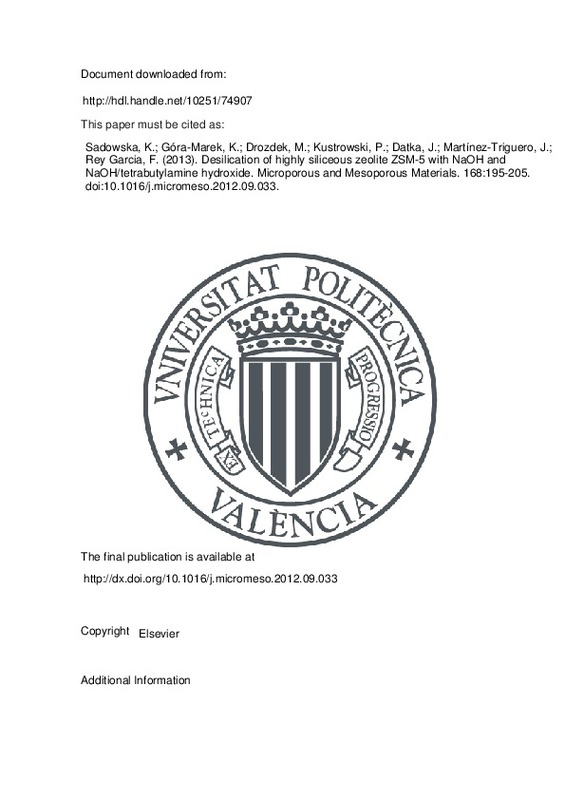JavaScript is disabled for your browser. Some features of this site may not work without it.
Buscar en RiuNet
Listar
Mi cuenta
Estadísticas
Ayuda RiuNet
Admin. UPV
Desilication of highly siliceous zeolite ZSM-5 with NaOH and NaOH/tetrabutylamine hydroxide
Mostrar el registro sencillo del ítem
Ficheros en el ítem
| dc.contributor.author | Sadowska, K
|
es_ES |
| dc.contributor.author | Góra-Marek, Kinga
|
es_ES |
| dc.contributor.author | Drozdek, Marek
|
es_ES |
| dc.contributor.author | Kustrowski, Piotr
|
es_ES |
| dc.contributor.author | Datka, J
|
es_ES |
| dc.contributor.author | Martínez-Triguero, Joaquín
|
es_ES |
| dc.contributor.author | Rey Garcia, Fernando
|
es_ES |
| dc.date.accessioned | 2016-12-02T10:20:44Z | |
| dc.date.available | 2016-12-02T10:20:44Z | |
| dc.date.issued | 2013-03-01 | |
| dc.identifier.issn | 1387-1811 | |
| dc.identifier.uri | http://hdl.handle.net/10251/74907 | |
| dc.description.abstract | The results of both chemical and XPS analysis pointed out that desilication of highly siliceous ZSM-5 of Si/Al = 164 was more effective in the surface zone than in the bulk, contrary to zeolite ZSM-5 of Si/Al = 31.6. According to the IR studies in parent zeolite the concentration of protonic sites was very close to the concentration of Al indicating that all Al atoms can form Si-OH-Al. The results of our quantitative IR studies strongly support the realumination thesis, i.e. some Al atoms extracted in basic solutions are subsequently reinserted forming new acidic hydroxyls. In desilicated zeolites all Al atoms were able to form protonic sites, however part of them dehydroxylated during the activation of zeolite producing Lewis acid sites according to the stoichiometry: one protonic site was transformed into one Lewis site. Low temperature nitrogen adsorption revealed that the alkaline treatment of highly siliceous zeolite with 0.2 M NaOH/TBAOH mixture produced mesopores of smaller diameter and narrower pore size distribution than in the case of zeolite of medium Si/Al ratio. This result can be explained by low concentration of Al which similarly as TBA(+) cations plays the role of pore directing agents (PDA). Contrary to TEA(+), the presence of Al in desilication mixture, led to the formation of larger pores. Therefore, in highly siliceous zeolite TBA(+) played dominant role as PDA producing narrower pores. Highly siliceous zeolite with uniform distribution of relatively narrow pores may be useful catalyst or catalyst support. The influence of desilication temperature on porosity development was also investigated. The increase of desilication temperature from 338 to 353 K resulted in both more extensive demetalation (more Si and Al is extracted) and the distinct increase of the volume and surface of mesopores. Both lower concentration of protonic sites and higher concentration of Lewis sites confirmed partial zeolite destruction upon desilication at elevated temperature. The experiments of pivalonitrile sorption followed by IR spectroscopy showed a significant increase of accessibility of acid sites to bulky pivalonitrile molecules. (C) 2012 Elsevier Inc. All rights reserved. | es_ES |
| dc.description.sponsorship | The research was partially carried out with the equipment purchased thanks to the financial support of the European Regional Development Fund in the framework of the Polish Innovation Economy Operational Program (Contract No. POIG.02.01.00-12-023/08). | en_EN |
| dc.language | Inglés | es_ES |
| dc.publisher | Elsevier | es_ES |
| dc.relation.ispartof | Microporous and Mesoporous Materials | es_ES |
| dc.rights | Reserva de todos los derechos | es_ES |
| dc.subject | Desilication | es_ES |
| dc.subject | Realumination | es_ES |
| dc.subject | Highly siliceous zeolite | es_ES |
| dc.subject | IR spectroscopy | es_ES |
| dc.subject | Accessibility | es_ES |
| dc.subject | Cracking | es_ES |
| dc.title | Desilication of highly siliceous zeolite ZSM-5 with NaOH and NaOH/tetrabutylamine hydroxide | es_ES |
| dc.type | Artículo | es_ES |
| dc.identifier.doi | 10.1016/j.micromeso.2012.09.033 | |
| dc.relation.projectID | info:eu-repo/grantAgreement/EC/Operational Programme 'Innovative economy'/POIG.02.01.00-12-023%2F08/ | es_ES |
| dc.relation.projectID | info:eu-repo/grantAgreement/NCN//2011%2F01%2FB%2FST5%2F00915/ | es_ES |
| dc.rights.accessRights | Abierto | es_ES |
| dc.contributor.affiliation | Universitat Politècnica de València. Instituto Universitario Mixto de Tecnología Química - Institut Universitari Mixt de Tecnologia Química | es_ES |
| dc.description.bibliographicCitation | Sadowska, K.; Góra-Marek, K.; Drozdek, M.; Kustrowski, P.; Datka, J.; Martínez-Triguero, J.; Rey Garcia, F. (2013). Desilication of highly siliceous zeolite ZSM-5 with NaOH and NaOH/tetrabutylamine hydroxide. Microporous and Mesoporous Materials. 168:195-205. https://doi.org/10.1016/j.micromeso.2012.09.033 | es_ES |
| dc.description.accrualMethod | S | es_ES |
| dc.relation.publisherversion | http://dx.doi.org/10.1016/j.micromeso.2012.09.033 | es_ES |
| dc.description.upvformatpinicio | 195 | es_ES |
| dc.description.upvformatpfin | 205 | es_ES |
| dc.type.version | info:eu-repo/semantics/publishedVersion | es_ES |
| dc.description.volume | 168 | es_ES |
| dc.relation.senia | 260390 | es_ES |
| dc.contributor.funder | Jagiellonian University in Krakow | es_ES |
| dc.contributor.funder | National Science Centre, Polonia | es_ES |
| dc.contributor.funder | European Commission | es_ES |







![[Cerrado]](/themes/UPV/images/candado.png)

